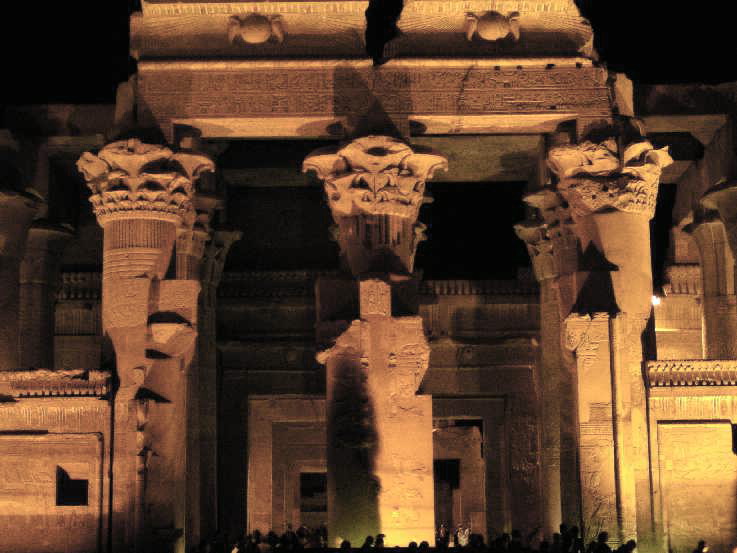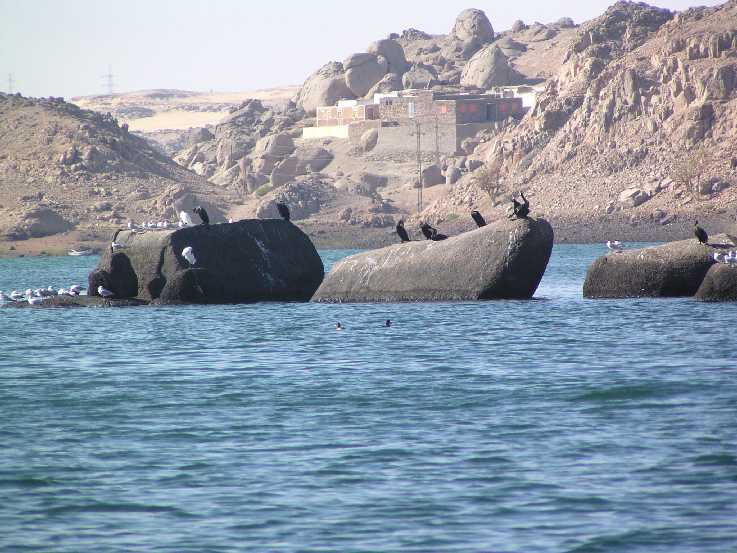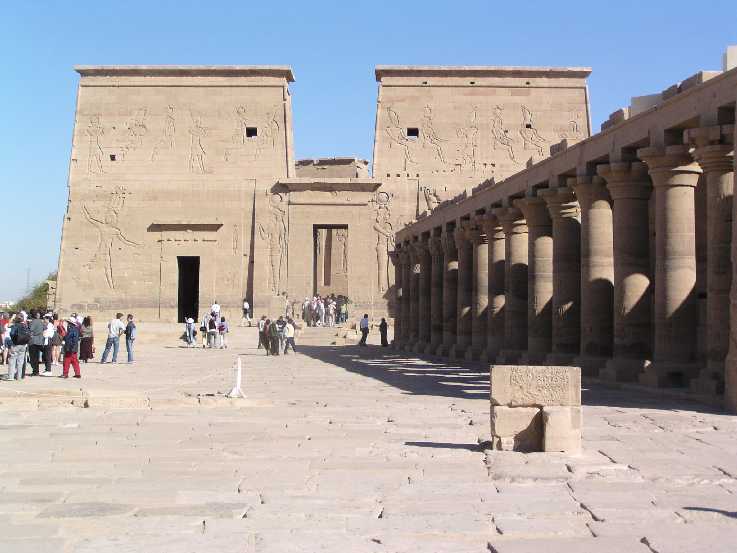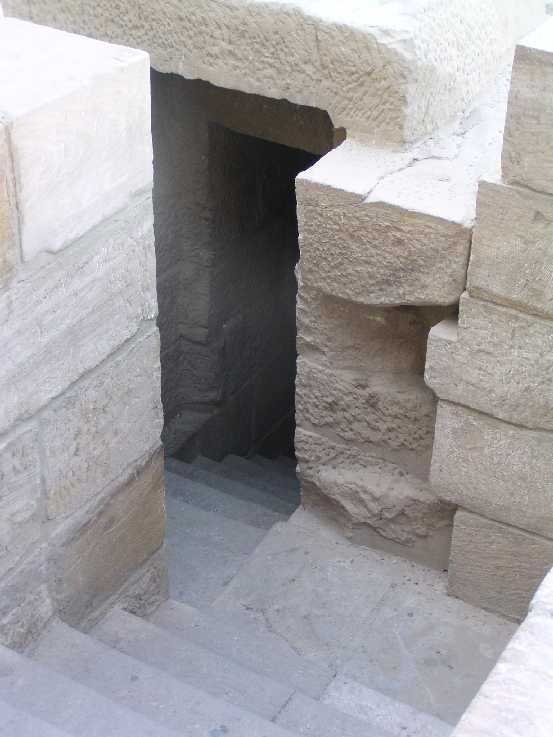Temple of Osiris at Abydos
Abydos is actually north of Luxor and we travelled there, and to Dendera, in a convoy of buses with a military escort. The Temple of Osiris was famed in ancient times as the spot where the head of the god Osiris was believed to have been buried.
Osiris & Isis
In myth, Osiris' brother Seth hacked him to pieces and scattered them. Then his wife Isis found all the pieces, put them together and, as our guide Hanan said in a Freudian slip, caused his 're-erection' to father the god Horus. Osiris then became the god of the afterlife and is usually shown wrapped as a mummy, as here.
Isis
The colours in this part of the temple are particularly well preserved.
Hieroglyphs
A large part of the temple was built by the New Kingdom pharaoh Seti I; his sections have raised-relief carvings that are very beautiful.
Seshat
Other parts of the temple were completed by Seti's son Ramses II. Perhaps because he was involved in so many building projects across Egypt, he used at Abydos the cheaper sunk-relief form of carvings. This is the goddess Seshat, recording the measurements of the temple.
Dendera Temple of Hathor
At Dendera is the much later temple of Hathor, from the Ptolemaic period. It is exceptionally well preserved and we were able to follow one of the procession stairways up to the roof level, where there are more chapels.
Nut
One of the lower chapels, a small square one, has this image of the sky goddess Nut on the ceiling. Her hands come down from above her head, holding her up, while she swallows the sun disk. According to myth, during the night it travels through her body and in the morning is reborn; the shining disk is visible at her belly, where she is bent at the hips.
Ship Cabin
We took the ship King of Thebes for our cruise. The cabin was lovely, with a huge sliding glass window the width of the room, two beds and a sitting area, as well as an ensuite.
The Nile
Vendors
We stopped for perhaps 6 hours waiting to go through a lock. Sometimes the wait can be 12 hours. During this time, vendors swarm about the ships in small boats, throwing cheap ghalabyas (the gown worn by men and women) and other similar things aboard. Those who wish to purchase the shoddy goods haggle over the price and then throw the money back down in the plastic bag the item was in.
Edfu Temple Pylons
Along the way we stopped at Edfu where there is another Ptolemaic temple, this time to Horus. It was the place where the statues of Hathor and Horus would travel from their own main temples, to meet halfway. We know the ancient name of the temple was 'House of the God [i.e. Temple] of the Beautiful [or Good] Meeting'. There are outer pylons that lead to...
Edfu Temple Forecourt
...an inner courtyard. Beyond that are the roofed hypostyle halls, and far within is the sanctuary where the god's statue would have been kept. Only the pharaoh or highest priests could go there; common people would not have been allowed further than this courtyard.
God Seth as Hippo
On the walls surrounding the halls is a set of scenes which show the story of how Horus defeated his uncle Seth, to avenge the death of his father Osiris. In this depiction, Seth is shown as a small hippo who really doesn't look like he has much chance against the spears and ropes of Horus and the other gods, one of whom is kneeling in a boat above.
Edfu Carving
The proportions of the carvings in this period are quite distinctively off from those of the more classical periods. In addition, sometimes the cartouches of the pharaohs were left blank due to uncertainty about which pharaoh was in power. The other cartouche is Ptolemy ('Ptolemaios may he live forever'), probably Ptolemy XII father of Cleopatra.
Boat
Along the Nile we saw various boats.
Fishing
Kom Ombo Dual Temple
In the evening we stopped at Kom Ombo, where the temple was dedicated jointly to Horus and Sobek, the crocodile god, and therefore unusually has a dual set of chapels and sanctuaries.
Kom Ombo Shrine
At the back wall of the sanctuary area was this small niche which would have contained a statue of the god. Since this was outside, common people could come here, and as assurance their prayers would be heard, the niche is flanked by eyes and ears.
Nile Scene
We continued along the Nile, seeing various scenes on the banks.
Tears of Isis
At Aswan are the first cataracts. The huge boulders are sometimes called the 'tears of Isis' that she wept as she searched for the scattered body-parts of her dead husband.
Philae Temple
On an island that is now in the reservoir behind the old, lower Aswan dam (where it was moved to rescue it from the flooding of the dam) is Philae ('Beloved'), where there is a temple to commemorate Isis' finding of the last part of her husband. The temple is of the Greco-Roman period.
Nilometer
Like the other non-mortuary temples, it contains a Nilometer. Before the dams were built, the flooding of the Nile was a yearly occurrence, necessary for the fertilisation of the land. Too high or too low a flooding meant problems and perhaps starvation, so the Egyptians tracked the rise of the Nile very carefully by measurements in these staircases that went down to the river.
Philae
After this last view at Aswan, we flew back to Cairo, had a lovely dinner in a palace built for the opening of the Suez Canal, and then home.
Home
When I arrived home, my cat decided that the palm fly-whisk Tamer had given us in Siwa was a wonderful chew-toy. I put it up on a bookshelf out of his reach - I thought! He has made a game of getting it, usually by jumping straight up into the air and batting the whisk off the shelf, but this time he managed to get onto the shelf - though he clearly doesn't fit - and is chewing on the whisk there. I'm glad even he has gotten something out of the trip!





